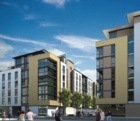Building the lower-carbon future

A ‘Very Good’ BREEAM rating has been achieved by this office development at 1 Linear Park in the Temple Quay Central development in Bristol. (photo: Stride Treglown)
One of the projects, a large office block, is due to open this July, while two further residential blocks are about to go on site. All are located in the Avon Street area, easily accessible by both rail and road. One project is an office block due to open this summer and which has ‘Very Good’ BREEAM certification. This 6-storey office block, at 1 Linear Park, is located on a remediated brownfield site and totals 4816 m2. ‘It’s the first of three high-profile office buildings in what is set to be the latest and most exciting commercial quarter of Bristol at Temple Quay Central — and an exemplar 21st century office development in terms of both aesthetics and sustainability,’ says Gary Milliner of Stride Treglown Architects, which designed the building. Its services have been designed to be as environmentally friendly as possible, in keeping with the latest legislation, which has a commitment to substantially reduce carbon emissions. The building’s ‘Very Good’ BREEAM acknowledges the various environmental benchmarks it has achieved. It also exceeds the Building Regulations’ carbon specification, with a 28% reduction in carbon-dioxide emissions compared to the Part L (2002) notional building requirements. Thermal and solar gain have both been optimised to reduce the heating and cooling loads. As a result, the heating requirement is minimal, especially due to enhanced building materials and minimal leakage. Solar shading has been installed on the south-facing façade windows to prevent unwanted heat and glare.
Similarly, the design has allowed for maximum daylight penetration, and Buro Happold’s building services team used a simulation model to investigate natural light entering the building and propose the appropriate level of artificial lighting accordingly, to avoid wastage. Acoustic design is also crucial to the building services provided, particularly due to the stringent planning conditions imposed to ensure that each building in Temple Quay does not impact on its neighbours — not least in this case on the adjacent hotel. Internal noise limits also achieve the BREEAM requirements. ‘This is a fine example of a modern office block, where lighting, heating and water use have all been minimised due to both design and the materials chosen,’ says Steve Clarke, Buro Happold’s project leader on the development. ‘We’re also delighted with the results our acoustic engineers have achieved in terms of avoiding noise pollution — and a small rainwater harvesting system feeds the green wall and tree planters.’

Environmentally friendly building services have been designed for The Eye residential development in Temple Quay Central in Bristol by Buro Happold. (photo: Castlemore)
‘We are very proud to be part of the redevelopment of Bristol,’ says Steve Clarke, ‘and are delighted to be contributing to the city’s future in a sustainable way.’
Project team:
Client: Castlemore Securities Ltd
Architect: Stride Treglown Architects (1 Linear Park and Affinity), Glenn Howells Architects (The Eye)
Buro Happold services: Building services on all three buildings; building services and structural engineering on The Eye. Acoustic engineering for The Eye and 1 Linear Park.
Main contractor: Balfour Beattie (The Eye), Wates (1 Linear Park). Affinity not yet appointed.








